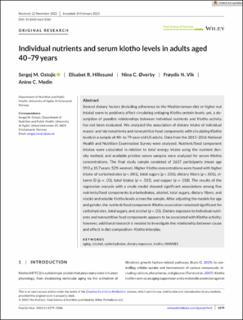| dc.contributor.author | Ostojic, Sergej | |
| dc.contributor.author | Hillesund, Elisabet Rudjord | |
| dc.contributor.author | Øverby, Nina Cecilie | |
| dc.contributor.author | Vik, Frøydis Nordgård | |
| dc.contributor.author | Medin, Anine Christine | |
| dc.date.accessioned | 2024-02-06T13:13:54Z | |
| dc.date.available | 2024-02-06T13:13:54Z | |
| dc.date.created | 2023-03-30T17:37:14Z | |
| dc.date.issued | 2023 | |
| dc.identifier.citation | Ostojic, S., Hillesund, E. R., Øverby, N. C., Vik, F. N. & Medin, A. C. (2023). Individual nutrients and serum klotho levels in adults aged 40–79 years. Food Science & Nutrition, 11(6), 3279-3286. | en_US |
| dc.identifier.issn | 2048-7177 | |
| dc.identifier.uri | https://hdl.handle.net/11250/3115950 | |
| dc.description.abstract | Several dietary factors (including adherence to the Mediterranean diet or higher nut intake) seem to positively affect circulating antiaging Klotho protein levels; yet, a description of possible relationships between individual nutrients and Klotho activity has not been evaluated. We analyzed the association of dietary intake of individual macro- and micronutrients and nonnutritive food components with circulating Klotho levels in a sample of 40- to 79-year-old US adults. Data from the 2015–2016 National Health and Nutrition Examination Survey were analyzed. Nutrient/food component intakes were calculated in relation to total energy intake using the nutrient density method, and available pristine serum samples were analyzed for serum Klotho concentrations. The final study sample consisted of 2637 participants (mean age 59.0 ± 10.7 years; 52% women). Higher Klotho concentrations were found with higher intake of carbohydrates (p < .001), total sugars (p < .001), dietary fibers (p < .001), vitamin D (p = .05), total folates (p = .015), and copper (p = .018). The results of the regression analysis with a crude model showed significant associations among five nutrients/food components (carbohydrates, alcohol, total sugars, dietary fibers, and niacin) and soluble Klotho levels across the sample. After adjusting the models for age and gender, the nutrient/food component–Klotho association remained significant for carbohydrates, total sugars, and alcohol (p < .05). Dietary exposure to individual nutrients and nonnutritive food components appears to be associated with Klotho activity; however, additional research is needed to investigate the relationship between cause and effect in diet composition–Klotho interplay. | en_US |
| dc.language.iso | eng | en_US |
| dc.publisher | Wiley | en_US |
| dc.rights | Navngivelse 4.0 Internasjonal | * |
| dc.rights.uri | http://creativecommons.org/licenses/by/4.0/deed.no | * |
| dc.title | Individual nutrients and serum klotho levels in adults aged 40–79 years | en_US |
| dc.type | Journal article | en_US |
| dc.type | Peer reviewed | en_US |
| dc.description.version | publishedVersion | en_US |
| dc.rights.holder | © 2023 The Author(s) | en_US |
| dc.subject.nsi | VDP::Medisinske Fag: 700::Helsefag: 800 | en_US |
| dc.source.pagenumber | 3279-3286 | en_US |
| dc.source.volume | 11 | en_US |
| dc.source.journal | Food Science & Nutrition | en_US |
| dc.source.issue | 6 | en_US |
| dc.identifier.doi | https://doi.org/10.1002/fsn3.3310 | |
| dc.identifier.cristin | 2138670 | |
| dc.relation.project | Universitetet i Agder: 689019 | en_US |
| cristin.qualitycode | 1 | |

